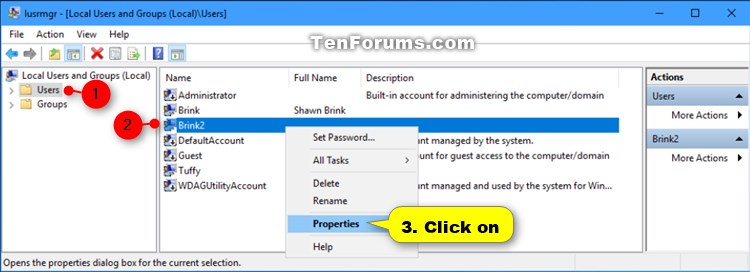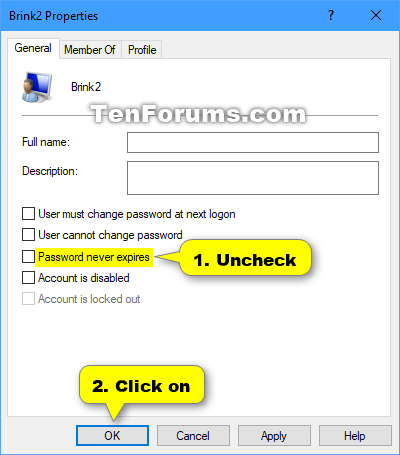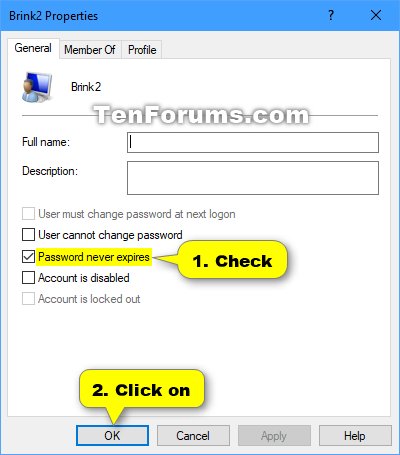How to Enable or Disable Password Expiration for Local Accounts in Windows 10
Password expiration is a feature in Windows that forces a local account on the PC to change their passwords when a specified maximum (42 days by default) and minimum ( 0 days by default) password age has been reached.
This tutorial will show you how to enable or disable password expiration for specific local accounts in Windows 10.
You must be signed in as an administrator to enable or disable password expiration.
Microsoft accounts will not be affected by this password expiration feature.
Contents
- Option One: To Enable or Disable Password Expiration for Local Account(s) using Local Users and Groups
- Option Two: To Enable or Disable Password Expiration for Local Account(s) using Command Prompt
EXAMPLE: "Your password has expired and must be changed" at sign-in


Local Users and Groups is only available in the Windows 10 Pro, Enterprise, and Education editions.
All editions can use Option Two below.
1 Press the Win + R keys to open Run, type lusrmgr.msc into Run, and click/tap on OK to open Local Users and Groups.
2 Click/tap on Users in the left pane of Local Users and Groups. (see screenshot below step 3)
3 Right click or press and hold on the name (ex: "Brink2") of the local account you want, and click/tap on Properties. (see screenshot below)
4 Do step 5 (enable) or step 6 (disable) below for what you want to do.
A) In the General tab, uncheck the Password never expires box, and click/tap on OK. (see screenshot below)
Password never expires will be grayed out if the User must change password at next logon box is checked.
B) If you like, you can change the maximum and minimum password age for local accounts.
C) When finished, go to step 7 below.
This is the default setting.
A) In the General tab, check the Password never expires box, click/tap on OK, and go to step 7 below. (see screenshot below)
Password never expires will be grayed out if the User must change password at next logon box is checked.
7 Repeat step 3 above if you would like to enable or disable password expiration for another local account.
8 When finished, you can close Local Users and Groups if you like.
1 Open an elevated command prompt.
2 Do step 3 (enable) or step 4 (disable) below for what you want to do.
A) Type the command below into the elevated command prompt, and press Enter. (see screenshot below)
wmic UserAccount where Name="user name" set PasswordExpires=True
Substitute user name in the command above with the actual user name of the local account you want to enable password expiration.
B) If you like, you can change the maximum and minimum password age for local accounts.
C) When finished, go to step 5 below.
This is the default setting.
A) Type the command you want below into the elevated command prompt, press Enter, and go to step 5 below. (see screenshot below)
(Apply to all accounts)
wmic UserAccount set PasswordExpires=False
OR
(Apply to specific local account)
wmic UserAccount where Name="user name" set PasswordExpires=False
Substitute user name in the command above with the actual user name of the local account you want to disable password expiration.
5 When finished, you can close the elevated command prompt if you like.
That's it,
Shawn
Related Tutorials
- How to Enable or Disable Password Expiration for Your Microsoft Account
- How to Enable or Disable PIN Expiration in Windows 10
- How to Change Maximum and Minimum Password Age for Local Accounts in Windows 10
- How to Enforce Password History for Local Accounts in Windows 10
- How to Change Minimum Password Length for Local Accounts in Windows 10
- How to Add Password to Local Account in Windows 10
- How to Allow or Prevent User to Change Password in Windows 10
- How to Change Password of Local Account or Microsoft Account in Windows 10
- How to Force Local Account to Change Password at Next Sign-in in Windows 10
- How to Reset Password of Local Account or Microsoft Account in Windows 10
- How to Remove Password of Local Account in Windows 10
- How to Change Account Lockout Threshold for Local Accounts in Windows 10
- How to Change Account Lockout Duration for Local Accounts in Windows 10
- How to Change Reset Account Lockout Counter for Local Accounts in Windows 10
- How to Remove Change a Password from Ctrl+Alt+Del Screen in Windows
Enable or Disable Password Expiration for Local Accounts in Windows 10
-
New #1
in steps 3 and 4, I believe it should say "password expiration" not "password protection" in the heading.
-
-
New #3
Quick potentially stupid question, in Option 2a, (Disable expiration applied to all users), does that also set it to disabled for future users as well, or would I need to reapply it if I created a new account on the system?
-

Enable or Disable Password Expiration for Local Accounts in Windows 10
How to Enable or Disable Password Expiration for Local Accounts in Windows 10Published by Shawn BrinkCategory: User Accounts
25 Apr 2021
Tutorial Categories


Related Discussions










 Quote
Quote
